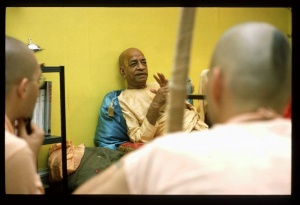CC Adi 4.106 (1975): Difference between revisions
(Vanibot #0027: CCMirror - Mirror CC's 1996 edition to form a basis for 1975) |
(Vanibot #0020: VersionCompareLinker - added a link to the Version Compare feature) |
||
| Line 2: | Line 2: | ||
<div style="float:left">'''[[Sri Caitanya-caritamrta (1975)|Śrī Caitanya-caritāmṛta (1975)]] - [[CC Adi (1975)|Ādi-līlā]] - [[CC Adi 4 (1975)|Chapter 4: The Confidential Reasons for the Appearance of Śrī Caitanya Mahāprabhu]]'''</div> | <div style="float:left">'''[[Sri Caitanya-caritamrta (1975)|Śrī Caitanya-caritāmṛta (1975)]] - [[CC Adi (1975)|Ādi-līlā]] - [[CC Adi 4 (1975)|Chapter 4: The Confidential Reasons for the Appearance of Śrī Caitanya Mahāprabhu]]'''</div> | ||
<div style="float:right">[[File:Go-previous.png|link=CC Adi 4.105 (1975)|Ādi-līlā 4.105]] '''[[CC Adi 4.105 (1975)|Ādi-līlā 4.105]] - [[CC Adi 4.107 (1975)|Ādi-līlā 4.107]]''' [[File:Go-next.png|link=CC Adi 4.107 (1975)|Ādi-līlā 4.107]]</div> | <div style="float:right">[[File:Go-previous.png|link=CC Adi 4.105 (1975)|Ādi-līlā 4.105]] '''[[CC Adi 4.105 (1975)|Ādi-līlā 4.105]] - [[CC Adi 4.107 (1975)|Ādi-līlā 4.107]]''' [[File:Go-next.png|link=CC Adi 4.107 (1975)|Ādi-līlā 4.107]]</div> | ||
{{CompareVersions|CC|Adi 4.106|CC 1975|CC 1996}} | |||
{{RandomImage}} | {{RandomImage}} | ||
==== TEXT 106 ==== | ==== TEXT 106 ==== | ||
| Line 25: | Line 24: | ||
<div class="translation"> | <div class="translation"> | ||
The heart of Lord Caitanya is the image of Śrī | The heart of Lord Caitanya is the image of Śrī Rādhikā's emotions. Thus feelings of pleasure and pain arise constantly therein. | ||
</div> | </div> | ||
| Line 32: | Line 31: | ||
<div class="purport"> | <div class="purport"> | ||
Lord | Lord Caitanya's heart was full of the feelings of Śrīmatī Rādhārāṇī, and His appearance resembled Hers. Svarūpa Dāmodara has explained His attitude as rādhā-bhāva-mūrti, the attitude of Rādhārāṇī. One who engages in sense gratification on the material platform can hardly understand rādhā-bhāva, but one who is freed from the demands of sense gratification can understand it. Rādhā-bhāva must be understood from the Gosvāmīs, those who are actually controllers of the senses. From such authorized sources it is to be known that the attitude of Śrīmatī Rādhārāṇī is the highest perfection of conjugal love, which is the highest of the five transcendental mellows, and it is the complete perfection of love of Kṛṣṇa. | ||
These transcendental affairs can be understood on two platforms. One is called elevated, and the other is called superelevated. The loving affairs exhibited in Dvārakā are the elevated form. The superelevated position is reached in the manifestations of the pastimes of Vṛndāvana. The attitude of Lord Caitanya is certainly superelevated. | These transcendental affairs can be understood on two platforms. One is called elevated, and the other is called superelevated. The loving affairs exhibited in Dvārakā are the elevated form. The superelevated position is reached in the manifestations of the pastimes of Vṛndāvana. The attitude of Lord Caitanya is certainly superelevated. | ||
Latest revision as of 17:30, 26 January 2020

A.C. Bhaktivedanta Swami Prabhupada
TEXT 106
- rādhikāra bhāva-mūrti prabhura antara
- sei bhāve sukha-duḥkha uṭhe nirantara
SYNONYMS
rādhikāra—of Śrīmatī Rādhārāṇī; bhāva-mūrti—the form of the emotions; prabhura—of Lord Caitanya Mahāprabhu; antara—the heart; sei—that; bhāve—in the condition; sukha-duḥkha—happiness and distress; uṭhe—arise; nirantara—constantly.
TRANSLATION
The heart of Lord Caitanya is the image of Śrī Rādhikā's emotions. Thus feelings of pleasure and pain arise constantly therein.
PURPORT
Lord Caitanya's heart was full of the feelings of Śrīmatī Rādhārāṇī, and His appearance resembled Hers. Svarūpa Dāmodara has explained His attitude as rādhā-bhāva-mūrti, the attitude of Rādhārāṇī. One who engages in sense gratification on the material platform can hardly understand rādhā-bhāva, but one who is freed from the demands of sense gratification can understand it. Rādhā-bhāva must be understood from the Gosvāmīs, those who are actually controllers of the senses. From such authorized sources it is to be known that the attitude of Śrīmatī Rādhārāṇī is the highest perfection of conjugal love, which is the highest of the five transcendental mellows, and it is the complete perfection of love of Kṛṣṇa.
These transcendental affairs can be understood on two platforms. One is called elevated, and the other is called superelevated. The loving affairs exhibited in Dvārakā are the elevated form. The superelevated position is reached in the manifestations of the pastimes of Vṛndāvana. The attitude of Lord Caitanya is certainly superelevated.
From the life of Śrī Caitanya Mahāprabhu, an intelligent person engaged in pure devotional service can understand that He always felt separation from Kṛṣṇa within Himself. In that separation He sometimes felt that He had found Kṛṣṇa and was enjoying the meeting. The significance of this separation and meeting is very specific. If someone tries to understand the exalted position of Lord Caitanya without knowing this, he is sure to misunderstand it. One must first become fully self-realized. Otherwise one may misidentify the Lord as nāgara, or the enjoyer of the damsels of Vraja, thus committing the mistake of rasābhāsa, or overlapping understanding.